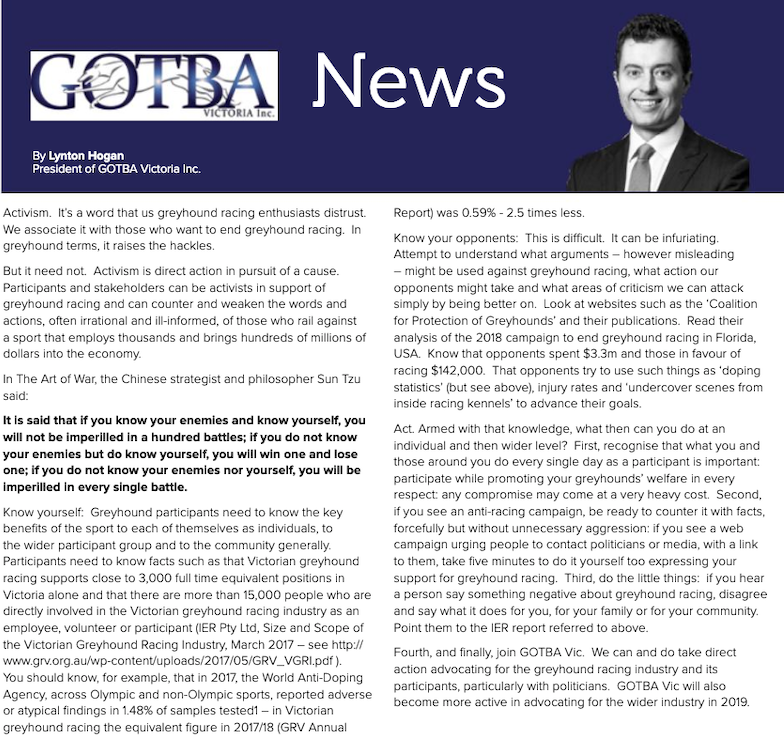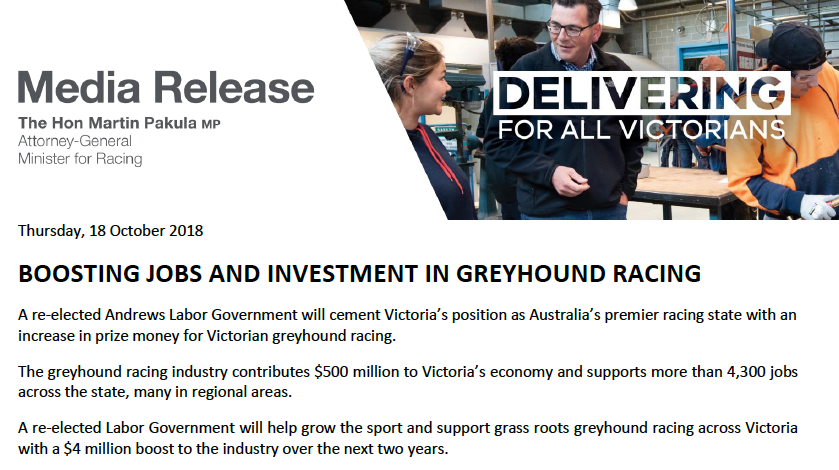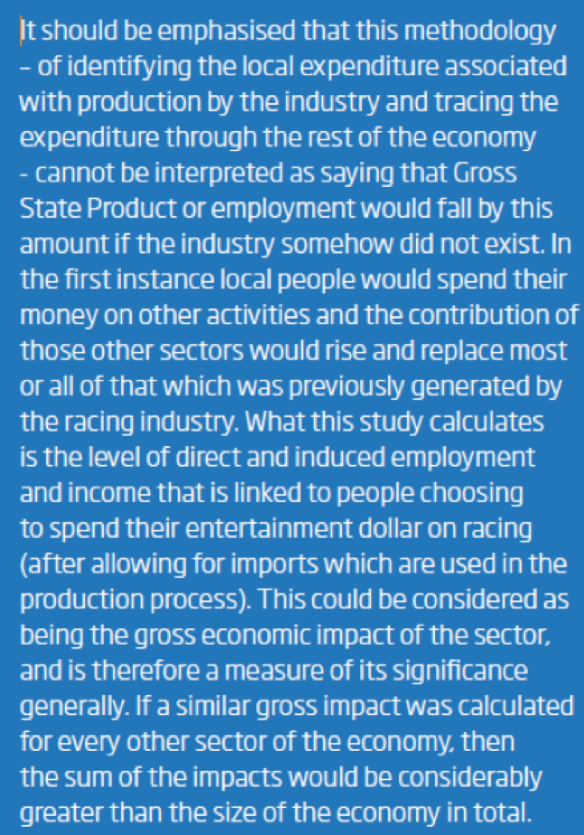Recently the Greyhounds Owners Trainers and Breeders Association (GOTBA) has called on their members to counter animal welfare advocates’ arguments against greyhound racing. In issue 36 of Greyhound Monthly Victoria, GOBTA state “Participants need to know facts such as that Victorian greyhound racing supports close to 3,000 full time equivalent positions (FTE) in Victoria alone.” [1; p. 14]. This same deceptive figure was also quoted in Greyhound Racing Victoria’s 2018 annual report.
See screenshot from the Greyhound Monthly Victoria magazine below.

During a Trump moment, in October, 2018 racing minister Martin Pakula quoted the substantially larger number of 4,300 jobs across the state and in many regional areas. In the same media release minister Pakula announced a $4 million dollar government contribution to the industry [2].

In the same media release minister Pakula announced a $4 million dollar government contribution to the industry.
What are the true employment numbers?
The fact is that there are not 3,000 FTE jobs in the greyhound racing industry.
According to a Greyhound Racing Victoria (GRV) commissioned Size and Scope report into the industry in Victoria [3], there are the equivalent of 2,888 FTE jobs generated by the industry. It is important to note that the report also makes clear the 2,888 figure includes indirect jobs. In fact, the total of direct FTE jobs is only 1,216.
Thus, 1672 FTE jobs are indirectly associated with the industry.
What is also made clear in the report is that the indirect jobs currently supported by greyhound racing would be absorbed by the consequent increased size of other sectors if greyhound racing ceased to exist.
Putting it into Perspective
Another way of looking at the importance of the greyhound racing industry to employment in Victoria is to examine the proportion of the Victorian population it employs. That figure is 0.000191% of Victorians.
The 4 million dollars of tax payer funds given by the government to the industry works out to $3,289.00 for each of the 1,216 people directly employed by the industry.
The larger figure of 11,000 people involved in the industry that is also quoted in the Size and Scope report includes owners in syndicates most of who will never have direct involvement with a racing dog. Moreover, there is likely some doubling up in the statistics since many people belong to more than one syndicate. These people are not employed by the industry. For them, it is a hobby – a cruel hobby.
It is clearly stated in the Size and Scope report that the methodology used precludes interpreting the statistics as indicating that “Gross State Product or employment would fall …… if the industry somehow did not exist”. The statement continues “In the first instance local people would spend their money on other activities and those sectors would rise and replace most or all of that previously generated by the racing industry.” (see screenshot taken from the Size and Scope report below).

An Industry in Economic Decline with No Social License
Despite public acceptability of the industry declining following exposure of its animal cruelty and criminal activities [4, 5], governments continue to push the baseless argument that it makes an important contribution with regard to income and employment.
As we have written elsewhere [6], objective indices of the economic contribution provided by the racing industry (see IBIS World annual reports) [7] have consistently shown an economic decline in the dog and horse racing industry.
Why Prop Up a Dying Industry?
A couple of reasons stand out for the support that governments continue to give to the racing industry. First among these is that governments are dependant on the gambling revenue – despite the misery of gambling addiction, the links between gambling and domestic violence, the effect of gambling on low income households and the killing of thousands of young greyhounds every year [6]. Another powerful reason, and probably the most important reason, is that governments are protecting their vote. As was clearly seen in NSW following the ban News Corporation, who also owns Punters.com, ran a concerted campaign to bring down the Coalition government unless the ban was revoked. The campaign was opportunistically embraced by the Shooters, Fishers, and Farmers party and together they won.
References
- Greyhound Monthly Victoria – Issue 36 https://issuu.com/greyhoundracingvictoria/docs/gmv_issue_36
- Pakula Media release (October, 2018)
https://www.premier.vic.gov.au/boosting-jobs-and-investment-in-greyhound-racing/?fbclid=IwAR0wSwXG-tOgodyvGMPCbq6BjWZbp8Irdj-AMnWLk5D4BnxlrOXDpTsq6bU) - Size and Scope of the Victorian Greyhound Racing Industry.
http://www.grv.org.au/wp-content/uploads/2017/05/GRV_VGRI.pdf - Greyhound racing: 82 per cent want Australia-wise industry shutdown, poll finds (July, 2016). https://www.abc.net.au/news/2016-07-15/82-per-cent-want-australia-wide-ban-on-greyhound-racing-poll/7633998
- Greyhound racing heavyweights John and Wayne Vanderburg admit possessions of weapons, steroids. Sydney Morning Herald (November, 2017). https://www.smh.com.au/national/nsw/greyhound-racing-heavyweights-john-and-wayne-vanderburg-admit-possession-of-weapons-steroids-20171107-gzglj8.html
- Government support for greyhound racing is self-serving and justified through the deception that it provides economic benefits. https://coalitionprotectgreyhounds.wordpress.com/2018/12/20/government-support-for-greyhound-racing-is-self-serving-and-justified-through-the-deception-that-it-provides-economic-benefits/
- Horse and Dog Racing in Australia (November, 2017). Gone to the dogs: Weak demand conditions are forcing smaller operators out of the industry. IBISWorld Industry Report R9120.